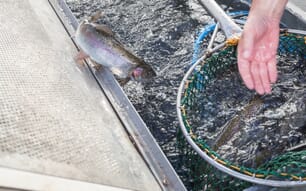The plan will cover seafood production for 100 million people and create 56,000 jobs, according to a new report.
The World Health Organisation recommends increased consumption of seafood in the interests of public health. At the same time, Norway manages some of the world's richest fish stocks and has a coastline that is very well suited to aquaculture. The government therefore has an ambition to develop Norway into the world's leading seafood nation, and FHL (Norwegian Seafood Federation) thinks this is a realistic goal through better utilisation of wild resources and the development of the aquaculture sector.
In the report "Seafood 2025" FHL describes how aquaculture can contribute to increased food supply. It requires strengthened efforts in aquaculture research, technology development, environmental initiatives and promoting increased production.
"Aquaculture is a very effective form of food production, and it will help to mitigate the lack of seafood in the world. At the same time it creates significant aquaculture industry development, jobs and high value creation in our country," said Fredd Wilsgrd, deputy chairman of the board of FHL.
The report shows that only taxes from the aquaculture industry in 2025 will amount to over 20 billion, which alone could finance the 25,000 nursing homes or 158,000 kindergarten.
"This requires the establishment of long-term policy objectives for development, and considerations of the environment, food production, profitable businesses and vibrant communities must be balanced. In this way, aquaculture will provide a fundamental contribution to the welfare of the state and the vision of becoming the world's leading seafood nation," emphasised Mr Wilsgrd.
The report "Seafood 2025" is based on the fact that Norway has unique natural conditions for conducting aquaculture, and that a growth in food production must take place within sustainable limits. Central to this is the control of sea lice and escapes, an area where the industry itself has taken comprehensive additional measures in recent years with good results.
NHL thinks that politicians are responsible for determining what are the limits of acceptable environmental impact of aquaculture, based on expert advice from leading experts. Environmental monitoring must be based on measurable indicators, and the industry for its part must take action so that one does not exceed the limits.
The report also highlights other significant challenges such as the protection of fish, availability of feed resources, exploitation of leftover raw materials, technology and research needs.
One of the major challenges ahead is access to coastal areas for food production in the sea. Although the number of localities have become fewer, while it produced more salmon and trout than ever, the industry has a need for more and well suitable locations.
"Norway has a coastal zone with great potential for seafood production. The fact that in 2011 it produced one million tons of salmon in only 0.5 per cent of the coastal area clearly illustrates the possibilities," said Mr Wilsgrd.
FHL is committed to promoting coexistence in order to trigger the seafood potential in all sectors. This implies a need for more research related to ecology, current conditions along the coast, spawning and migratory patterns of wild fish stocks, and the extent to which aquaculture production affects wild fish. Development of new fishing methods for use in aquaculture facilities is also something that can strengthen the economic basis for the traditional fisheries.
"This report shows potential aquaculture operators what to strive for, and what opportunities and challenges inherent in a future production growth. We hope this provides a good basis for dialogue with governments, research institutions and environmental interests to realise the potential of seafood in Norway," says Fredd Wilsgrd.
Realising the Potential of Norway's Seafood
NORWAY - With knowledge that here is a lack of seafood in the world and that Norway has natural conditions to triple the production of salmon and trout to 2.7 million tonnes by 2025, the government wants to develop Norway into the world's leading seafood nation.
by Lucy Towers




